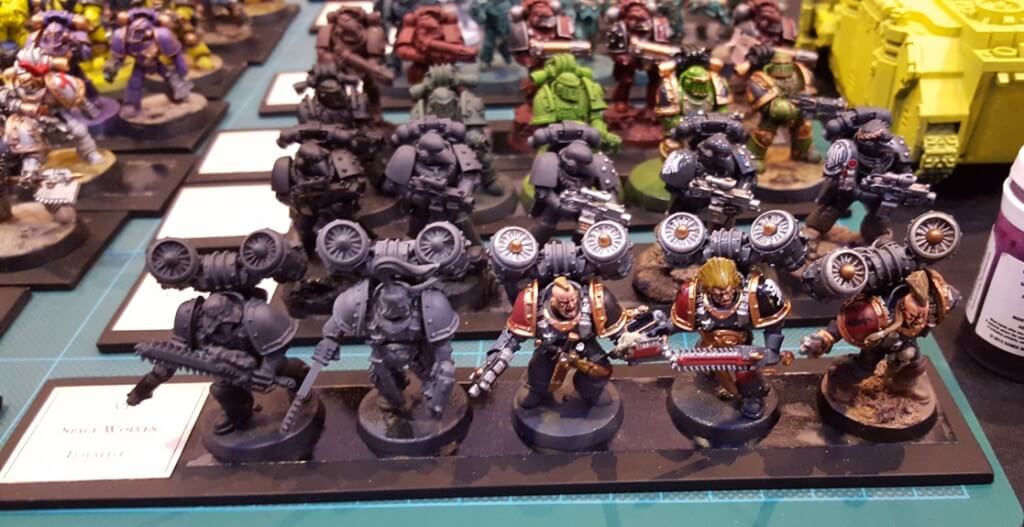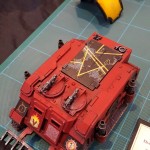
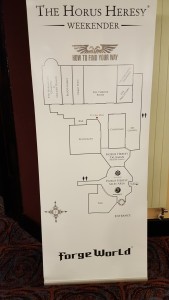 Well the Horus Heresy Weekender 2016 is over and what an event it was! Lots of new miniatures, lots of new information and “read between the lines” and plenty of photos taken! (some up on my new Twitter account but others will be added later on).
Well the Horus Heresy Weekender 2016 is over and what an event it was! Lots of new miniatures, lots of new information and “read between the lines” and plenty of photos taken! (some up on my new Twitter account but others will be added later on).
This was the first time I’d managed to do this event in its four year lifetime so I went in with a very open mind and came out really enthused. There were a couple of things that I felt could be improved which I’ll outline at the end of my very opinionated and immensely long review 🙂
Now I know that Penddraig on the 30k Forums will be doing a summary on all of the seminars he attended so won’t go too in depth on those, likewise Garro will also be doing a review on all of the rules related items that came out in the new Dark Age “red book” and Retribution (aka Book 6). So in order to compliment these I’m going to cover the three “Demo Pod” seminars I attended and give a rough overview of the event in general from my point of view.
I travelled up to the event with Penddraig on the Friday evening and met up with a few of the other people from the 30k Forum. We were staying in the Belfry Hotel where the event being held which is a five-star hotel and I cannot fault the staff and quality of food. Yes it was pricey for drinks (soft drinks especially) but actually I’ve been to more expensive places and it was a genuine pleasure to be served with staff who were happy and bent over backwards to help.* Plus having your base of operations in the same building means that you can wander round the whole event in just a t-shirt and any purchases can be taken back to the room.
I’m fairly positive that I missed speaking to other people who I know were at the event (Lil Legend was there as were the Imperial Truth podcast team) – next year I’ll likely be there with a Runebrush emblazoned t-shirt to make me a little more obvious – I’ve never liked going up to somebody who has no clue in hell who I am…
The event followed a similar format to many other Games Workshop events, a room of miniatures and displays, room with artists, room with authors, a couple of seminar rooms, gaming room, computer game area and an area for sales. What made this event unique is that the rooms changed throughout the course of the weekend and the whole event was very casual and relaxed. Tickets were limited to 350 and everybody knew that if a room was busy they could come back in half an hour and not miss seeing something. When I went into the art room one point, Neil Roberts was there with his portfolio (which is amazing) a few hours later I returned and they had Space Wolves artwork on the big screen. All of the rooms followed this gentle changing of the guard and in the miniatures room Saturday and Sunday had a different group of Forge World Model Makers in (who each brought in different things they’re working on).
What really makes this event unique though is being able to casually talk to the Forge World staff and “after hours” on the Saturday they have an hour for just chatting either to the rules authors (including Lord Alan Bligh) or as I did to a few of the painter/model makers. Despite the number of people who attended the event, these informal chats really don’t have many people come to them so they’re really entertaining and shows that the people behind the scenes are as mad and enthusiastic about the hobby as we are.
There were two-seminar rooms during the event with one of these being used for “Demo Pods”. I think roughly half of my time was spent in one seminar or other which for me was just about the right balance.
Painting Armies Seminar
This seminar was given by Mark Bedford and primarily covered the topic of painting up an army. The biggest tip Mark gave us was that you need to get yourself into the right metal state when painting an army and if you treat each miniature as its own Golden Daemon entry you’re never going to finish. That’s not to say you shouldn’t paint them to the best of your ability, but you need to find a way of painting a lot of miniatures all to an identical (and repeatable standard).
The first big tip Mark gave is that if you have a mountain of miniatures to paint, is to put them away in a cupboard or similar so they’re out of sight. There’s nothing as demoralising as painting a miniature or unit, putting it next to a stack of grey resin or plastic and realising how much more you’ve got to do. It’s far better to look at things that you have finished and get motivation from wanting to increase that number (rather than decrease the unpainted stack).
When painting units Mark always puts them onto a baton to paint. This isn’t an uncommon practice but what Mark tends to do is to put just five miniatures on the baton and then treats the whole baton as a single miniature. His theory is that if you’re starting to tire or get bored painting the edging on shoulder pads you can generally push yourself to get to the end of a baton of four or five miniatures. If you have too many you’ll stop in the middle and it’s more difficult to get that motivation to go back and finish.
When you’re painting an army you should try to never mix colours because it’s a massive waste of time. Buy the correct colour and use it. You won’t need to record a recipe and carefully mix it every time you need it.
There are techniques that will provide shortcuts and you should employ these when you’re painting an army to make your life easier. If you have an airbrush lay down your base colours with that, it’s significantly quicker than doing it by hand and when you’ve an army on the table, who actually cares how they were painted? It’s not cheating either, it’s just another tool in your toolbox.
One thing that I found interesting is that Mark (and as I found out later all of the Forge World painters) uses a lot of coats of gloss varnish between stages – more than I thought. The team’s preference is Halfords car lacquer although Purity Seal works OK too. This makes it easier to push washes round and apply transfers. With the transfers being produced currently, applying a transfer onto a gloss varnish using a decal fixer (aka Microsol and Microset) will eliminate the ghosting you often get. Once dry you can then distress the decal using a knife. Seal it all with a coat or two of gloss varnish and it’ll be bullet proof 🙂
Mark had brought along two Titan shoulder pads which had been painted using a marble technique. This was simply done using an airbrush and tearing masking tape to use the torn edge to achieve a nicely feathered marble vein. Each had also been given multiple coats of lacquer which had indeed made the finish really solid.
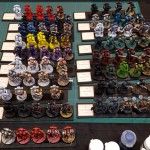 At the end of the seminar Mark showed us batons for each of the Space Marine Legions and when through a few on how he went about doing them – by the end he’d actually gone through each legion. The way he deals with all miniatures needing a white undercoat is to undercoat them black and then immediately (before the black is dry) give them their white undercoat. This mixes on the fly and makes a pale grey colour but gives a bit of pre-shading.
At the end of the seminar Mark showed us batons for each of the Space Marine Legions and when through a few on how he went about doing them – by the end he’d actually gone through each legion. The way he deals with all miniatures needing a white undercoat is to undercoat them black and then immediately (before the black is dry) give them their white undercoat. This mixes on the fly and makes a pale grey colour but gives a bit of pre-shading.
One very interesting bit of information that was given out was that the new Masterclass book wasn’t quite what they wanted to produce and that they will be releasing one that focuses on the Space Marine Legions, covering painting normal marines, a special unit and the appropriate Primarch. He also acknowledged that Forge World are aware this content was what people were expecting from the Masterclass book. It wouldn’t surprise me to see Mark’s Legion batons appear in this book as they are a really good example of painting rank and file marines. Another bit of information that I found interesting is that the reason the first two Masterclass books used different manufacturers paints and products was simply because nothing was being produced by Citadel to cover those particular items/colour. It was always the intention to produce a complete range of paints and solutions. This makes sense for a variety of reasons, bearing in mind the quantity of paint Forge World must use in a month, why purchase paints from elsewhere if you have a company that produces paint for you? Not only is it cheaper to pick up a pot from stock, it also means that you now control the colour and will know it’s available as long as you want it to be.
Painting Vehicles
This seminar was presented by Phil Stutcinskas and I wasn’t entirely sure what to expect. Ideally this needed to be attended after the Airbrushing seminar he presented earlier in the day (which I skipped as I knew it was repeated on the Sunday). The seminar covered a couple of ways of weathering an Ultramarine Land Raider and a lot of the theory behind it.
The one item Phil emphasised that weathering should be applied in lots and lots of layers and you need to think about what you’re doing as you go along. You may end up doing chipping, rain, more chipping, rust, rain and then more chipping. This basically makes the end result much more effective as it makes it look like the vehicle has been battered over a period of time with different things.
Chipping was quite an interesting subject as he uses a combination of sponge and a brush to achieve chipping effect. For a dark vehicle, he will use a light colour first and then apply a darker one. In the case of the Ultramarine Land Raider he used a light blue followed by a brown-red. Chipping should be applied to areas that are going to be chipped rather than all over to form a mess. Phil said that he will often use chipping to provide a “reverse edge highlight”, so going dark on an edge rather than light. He also is a massive fan of using a brush to refine and extend from the sponge. The sponge is very imprecise whereas a brush allows you to achieve pin-sharp chips. One very interesting point he made is that the darker your chip colour the sharper it needs to be. A super sharp black chip will have more depth than a dark brown chip, however if you aren’t able to achieve the sharpness, use a colour that isn’t quite as dark as a black chip that isn’t sharp will look like a mistake.
He did point out that rain runs down vertical surfaces but not on horizontal surfaces. Now this is the most obvious comment ever, but as he pointed out, how many tanks have you seen with rain streaks down the side but the top of the tank is pristine? Where did the rain come from?
Equally dirt collects inside areas (effectively where the shadow would be). One way of achieving this is to thin down your dirt colour using the Citadel Air-Caste medium and applying quite a lot of it using an airbrush. It will then naturally pull itself into the areas it would collect.
The final item Phil covered is that you need to ensure whatever dirt colour you pick, should contrast against the colour of your vehicle. Sandy coloured dirt looks amazing on a black vehicle, but barely noticeable on a yellow one. The colour wheel is a good tool to pick a colour that is on the opposite side to your hull colour. He did say though that it’s not an exact science (blue dirt) although a similar theory can be applied to the colour of the chips. Red is opposite green so using a red-brown colour on a green hull looks really effective.
One interesting thing that I picked up on is that Phil tends to use the Citadel Air range in preference to the traditional layer/base paints. Now this may be because he’s a big airbrush user, but when he was doing sponge chipping it does seem that the air paints stay wetter and don’t become dusty when they dry.
Meet the Pros (evening ‘seminar’)
I think this was probably the highlight of my weekend, five of us sat down with Mark Bedford, Phil Stutcinskas and Pedro before dinner on the Saturday and each of us got a chance to show photos and quiz them about various bits and bobs. It was really informal and good laugh, it’s very obvious that the guys are still passionate about the hobby – Mark had been working on the batons of marines at home until the early hours for the past couple of weeks so they’d be ready in time. What was really nice was that everybody could chip in whenever they wanted. I can see me regularly doing this and it’s a good opportunity to bring along items for a “show and tell”. One lady brought along a load of Imperial Fists which from where I was sat looked really nice. I managed to grab a few ideas on things to try to get a black colour that matches my red for my Knights too, so I’m really chuffed on that. The general consensus though is that having a dedicated area where you live is the best way to build up your skills and as Phil says painting is only 10% technique and 90% practice.
Airbrushing
The airbrushing seminar was really packed in comparison to the other demo pods which meant that annoyingly I didn’t get a seat. It was being given by Phil Stutcinskas again who I discovered during the seminar was one of the main people involved in developing the Forge World Airbrush paints which took around 2 years of backward and forwards between him and the paint company. My gut feeling is the Citadel airbrush paints were developed roughly the same sort of time and Phil rates both of them as being ideal.
In principal the seminar itself was pretty simple, Phil airbrushed a Land Raider through a number of lighter greens and then a little bit of dirt weathering which he had premixed in a bottle – Ungor Flesh and lots of Air-Caste Medium.
He then demonstrated two ways of doing marble. In both you need to basecoat the “main” colour and then airbrush the veins on. The first method you thin your vein colour down quite a bit, whack down a fairly decent layer and then use just air from the airbrush to spider the paint round. Repeat this around four times and you’ll end up with a nice finish. The second way was the slightly more complicate way using masking take. As Mark had outline you tear the tape and use the torn feathered edge. You can just use one piece of tape (focus the paint onto the tape so you get a gentle soft blend) or two pieces to create a fracture line. Then he’d put a thin coat of the base colour on to blend it in, varnish it and then repeat the process the next day (24 hour drying for varnish). Finally use a dirt effect to “shade”.
Although my summary makes it seem like Phil didn’t do much, he outlined quite a lot of routine technique. He admits that he’s a bit of a lazy painter so tends to mix his paint in the cup, what is interesting is that to mix, he holds a piece of blue roll cloth over the needle and then uses air blow back to mix. He also does the same for cleaning it out between colours, pouring out the paint adding a bit of Forge World Solution, spraying a bit through and then blow back to remove any other crap.
Phil seems to use Air Caste Medium to make the paint more translucent and Forge World Solution to thin the actual paint to make it flow through the airbrush better. I must admit I’ve never thought of using both together. He also said that Air Caste Medium is basically a better version of Lahmia Medium (which is milky) as it doesn’t taint the paint colour – the milky aspect is matting medium and though it dries clear adds a bit of white to the mixed colour. He kept referring to it as “gloss” so I plan to do some experimentation to see what finish I get.
New Stuff!
Now it would be remiss of me not to cover some of the new miniatures 😉 In comparison to some FW events, there wasn’t the deluge of new items that I’ve seen in the past as quite a selection were announced at the Birthday Event. However I do think this should be seen as a case of quality and not quantity.
I can’t recall everything that was released off the top of my head but later on will post up an album of pictures of all the new items (a few appeared on my Twitter feed). However from what I can reacall:
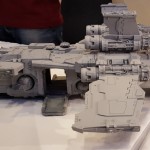 The Stormbird is almost ready for the production guys to start casting up, Phil has done a beautiful job on this 5.5kg monster and it looks like this will be the end of an era as FW move entirely onto 3d CAD.
The Stormbird is almost ready for the production guys to start casting up, Phil has done a beautiful job on this 5.5kg monster and it looks like this will be the end of an era as FW move entirely onto 3d CAD.
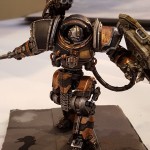 The iron circle/domnitor battle automata are amazing and a really nice blend of all the various designs within the Mechanicum and the Iron Circle that Mark Bedford painted up for fun looks amazing.
The iron circle/domnitor battle automata are amazing and a really nice blend of all the various designs within the Mechanicum and the Iron Circle that Mark Bedford painted up for fun looks amazing.
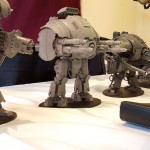 The new Questoris Knight Porphyrion is absolutely amazing and means my prediction of a new variant was correct. I don’t think anyone was expecting Darren Parwood to bring a freshly 3d-printed one along with him on Sunday (including Tony Cottrell from the sound of it). The Porphyrion looks visually very similar to the old Epic Warden and is designed to fulfil a long-range heavy support roll – and the current draft of the rules makes it more than capable of doing this.
The new Questoris Knight Porphyrion is absolutely amazing and means my prediction of a new variant was correct. I don’t think anyone was expecting Darren Parwood to bring a freshly 3d-printed one along with him on Sunday (including Tony Cottrell from the sound of it). The Porphyrion looks visually very similar to the old Epic Warden and is designed to fulfil a long-range heavy support roll – and the current draft of the rules makes it more than capable of doing this.
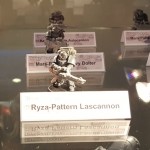 Extra heavy weapon options are being added in the form of an underslung design and Rob confirmed that they are compatible with the plastics and MkII, III and IV. By having an underslung set the thought is that they look better for armies that are more aggressive or faster moving and the shoulder supported ones more styled for defensive and slower armies.
Extra heavy weapon options are being added in the form of an underslung design and Rob confirmed that they are compatible with the plastics and MkII, III and IV. By having an underslung set the thought is that they look better for armies that are more aggressive or faster moving and the shoulder supported ones more styled for defensive and slower armies.
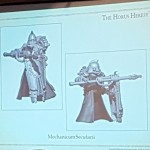 The Secutarri upgrade kit for the Mechanicum was announced in the Titan seminar (Penddraig’s review has the full info) – I can honestly say that they look amazing and they’re going to be usable in 40k too.
The Secutarri upgrade kit for the Mechanicum was announced in the Titan seminar (Penddraig’s review has the full info) – I can honestly say that they look amazing and they’re going to be usable in 40k too.
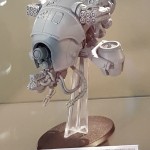 Finally there is the first in a number of new battle automata that look similar to blight drones. Speaking to the sculptor he wanted something that shared a family feeling although he did say that this particular variant might not the be actual ones that become corrupted. One thought he has is something similar that is basically just a massive bomb!
Finally there is the first in a number of new battle automata that look similar to blight drones. Speaking to the sculptor he wanted something that shared a family feeling although he did say that this particular variant might not the be actual ones that become corrupted. One thought he has is something similar that is basically just a massive bomb!
Summary
I really enjoyed the Horus Heresy Weekender 2016, I managed to take lots of photos (apologies if anybody got hacked off with me taking snaps of slides in the seminars) and overall it ran really smoothly. This was the first time the Warhammer World Events team had ever run a Forge World event and in places it showed, yet again the sales stand was a mess which I believe was avoidable – however it wasn’t the rugby scrum of violence I’ve known at Games Days in the past. I’ll compose an observational/suggestion e-mail later on as feedback is the only way the team know areas they can improve on and (just as importantly) areas they got right!
Seminars ran as smooth as most with a mixture of brilliant information and idiotic questions – although quite why the bloke sat next to me insisted on spending the majority of the Inferno seminar sending an e-mail to a mate is beyond me.
It’s pretty certain that Blood Bowl is to be the first Specialist Game to be released and there is a general hope that a new Adeptus Titanicus could be the next project as certain resources can be re-used from the Heresy range such as resources and CAD models – although a CAD model does need work on to remove some of the details such as rivets. This wouldn’t use recycled Epic rules either – it would be a brand new game in its own right (which really does make me excited).
There were a few surprises and I’m really chuffed that my prediction of a new Knight variant has come true, the Porphyrion is very similar to the Epic version of the Knight Warden and Darren Parwood surprised us all (including Tony Cottrell) on Sunday by bringing a 3d print of one along for us to gaze at longingly. Seeing the work in progress of Leman Russ was also amazing although I’m still sceptical that he’ll be the “next” Primarch as there are others to be released. I also must mention the under slung heavy weapons made by Rob Smallwood which look amazing 🙂
I was sad that there wasn’t an Horus Heresy Weekender 2016 miniature (or infact any event miniature). I’m sure that this will be rectified during the year and Warhammer Fest is in May so likely see an event miniature appear there. At the end of the final presentation Tony did elude that there may be an extra event before the 2017 weekender and as Penddraig and I said on the way home, it wouldn’t surprise me if they do a big release for Inferno which has been anticipated for at least the past 7 years. This is why I don’t think Russ will be the next Primarch as it was confirmed that he’ll be duelling Magnus so they need to have both miniatures ready in case any changes need to be made.
* It’s worth noting that the Belfry offer a special room rate if you were attending the Horus Heresy Weekender 2016 which includes a buffet breakfast, if you room share it actually makes it as cheap as some budget hotels.
